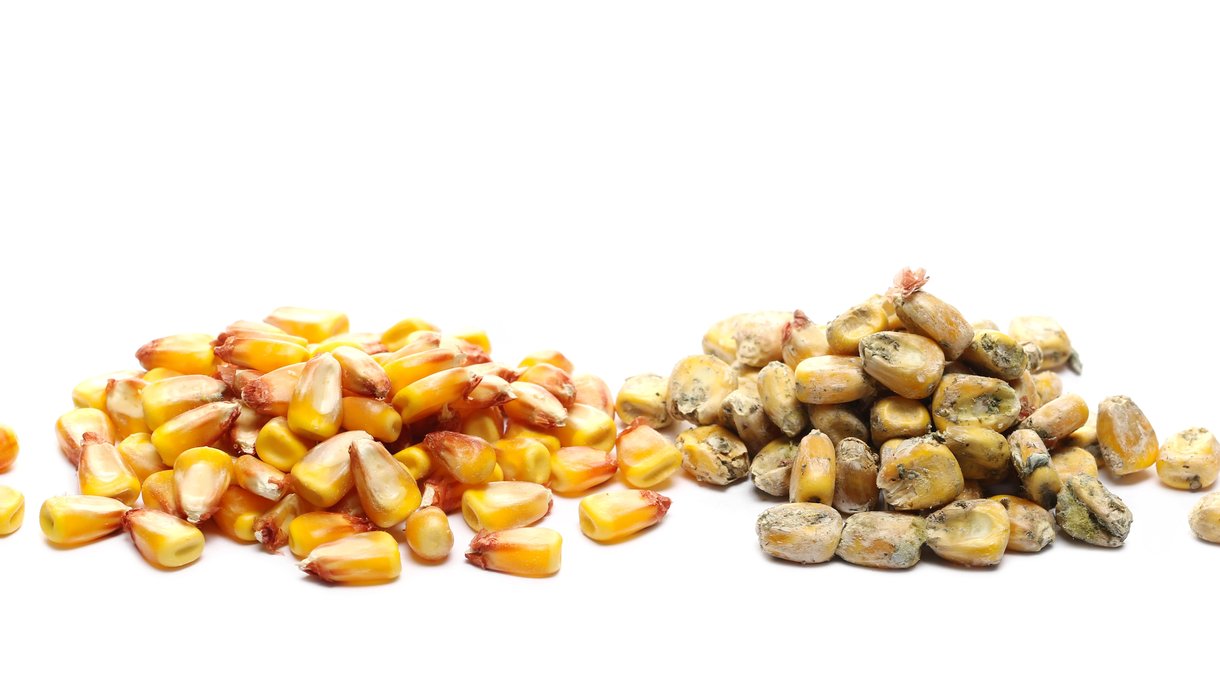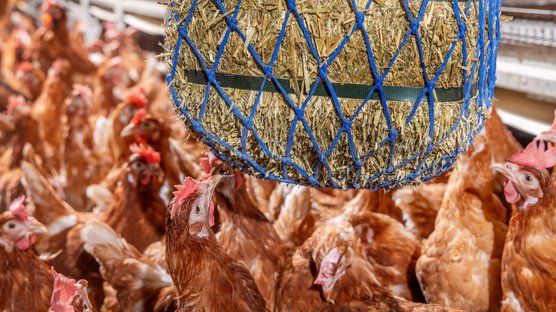
Published on May 4, 2022
Mycotoxins: Small in size, big in damage
The genetic improvement of laying hens has provided a constant increase in the quantity and quality of eggs and helps egg producers to obtain better economic profitability flock after flock. Factors such as rising production costs, new animal welfare requirements and increased consumer demand make egg producers pay attention to flock productivity and loss reduction throughout the production process. Poultry flocks that suffer from low egg production and/or high mortality result in less profitable flocks.
Poultry nutrition plays an important role in conjunction with other areas of knowledge, such as flock management, chicken health, farm environment. In addition to knowing and meeting nutritional requirements of the chickens, it is important to protect flocks from anti-nutritional factors that reduce the chickens' nutrient utilization and from substances that harm the chickens’ general metabolism. In both cases we have flock performance losses. In this sense, mycotoxins are important to be studied, avoided and controlled because they are substances that can cause technical and economical losses in poultry flocks.
Mycotoxins are compounds produced by different types of fungi (such as fungi of the genus Aspergillus and Fuzarium) that grow on ingredients of plant origin such as corn, wheat, barley oats, triticale, soya, rice, sunflower, rapeseed, peanut, etc. These ingredients are important sources of energy and protein for poultry and demand a large storage and processing structure for the production of feed. Thus, the care in the prevention and control of mycotoxins goes through the acquisition of raw materials, storage and processing of grains until the feed that will be consumed by birds. Interesting to know that most mycotoxins are stored in the outer layers of the grains. Bran rich materials therefore often contain higher levels of mycotoxins, for example wheat bran can contain 6 times higher levels compared to whole wheat.
The production of mycotoxins occurs as a defense mechanism of the fungi against invaders and/or when the fungi find optimal conditions for multiplication. Therefore, mycotoxin contamination can start in the field, before the grain is harvested. However, it can also happen after harvesting or during storage or transport. This is mainly influenced by the presence of insects and the climate conditions. Therefore, inadequate and poorly controlled grain sourcing and storage methods generate the first phase of attention.
Among the best known mycotoxins are: Aflatoxin, Trichothecene, Ochratoxin, Fumonisin, Zearalenone, Cyclopiazonic acid, Fusaric acid. Each of these mycotoxins has different effects on poultry:
- Presence of thrush in the beak and under the tongue (usually unilateral)
- Darkening of the tip of the tongue (may result in necrosis)
- Ulcerations and abrasions on the gizzard
- Interdigital skin lesions
- Livers yellowish, friable, with color variation and rounded edges
- Accumulation of urates in the kidneys
- Bleeding points in muscles (chest and inner thighs)
- Drop in egg production and egg quality
- Reduced feed digestion (presence of undigested particles in the feces)
- De-standardization of ovarian development (failure to lay and/or 2-3 buds developing simultaneously)
- Reduced breeder male fertility
- Reduction in hatchability and chick quality of 1-day-old chicks
In addition to these visual changes, the following are also reported: lower pullets' weight gain, worsening feed conversion, immunosuppression with reduced immune response (impaired vaccine response), reduced medication action time, more severe cases of respiratory problems, and Salmonella.
These changes are usually more easily seen in chickens that are actively laying eggs and sometimes we are influenced by ourselves to think that rearing chickens are not suffering from the same problem because we don't see these changes so clearly. However, it is worth remembering that the inputs that both chickens consume are the same, and that younger chickens tend to be more sensitive to mycotoxin contamination. In the table below are listed some reference values for the tolerance of chickens to different types of mycotoxins.
| Aflatoxin | Fumonisin | Ocratoxin | Deoxyinivalenol (DON) | HT2 | T2 | Zearaleone | Diacetoyscirpenol (DAS) | |
|---|---|---|---|---|---|---|---|---|
| Broilers – Starter | 0 | 100 | 0 | 200 | 0 | 0 | 10 | 0 |
| Broilers – Grower | 2 | 500 | 2 | 500 | 10 | 50 | 20 | 200 |
| Broilers – Final | 5 | 500 | 5 | 1000 | 10 | 50 | 20 | 200 |
| Laying hens | 10 | 1000 | 5 | 1000 | 20 | 100 | 50 | 500 |
| Breeders / parent stock | 10 | 1000 | 5 | 1000 | 20 | 100 | 50 | 500 |

It is worth noting that: 1. these values were determined individually, 2. challenges in the field do not always happen in isolation/individually, 3. there is synergistic action between mycotoxins.
It is not always possible to perform detailed mycotoxin analysis, laboratory analysis is not cheap and not always available. However, frequent monitoring of the quality of the grains (broken grains, out of standard, excessive humidity) helps in this first control. Additional cares during the receiving and storage of the grains are important, such as the use of pre-cleaning, use of organic acids in grains that will be stored for long periods. Another point to consider is that the grain that goes into the silo and that stays at the base of the silo is the first to enter and the last to leave, and this can cause variation in the level of feed contamination. The correct aeration of the silos is also important to avoid moisture condensation points inside the silos.
Detection of the presence of mycotoxins is dependent on sampling. Furthermore, mycotoxins are often not nicely spread, but occur in specific spots. The right sampling of raw materials is useful for identifying the initial source of contamination. But barn feed sampling is important to evaluate the amount of mycotoxins the birds are consuming. Histopathological analysis of the birds is a useful tool in closing the diagnosis of mycotoxin problems.
The contamination identified in the feeders indicates that there may be points of fungal proliferation along the feed production chain:
- Receiving contaminated raw materials
- Storage faults with infiltration points and condensation of humidity in the silos
- Rainwater infiltration at grain transportation points (conveyors, elevators)
- Infiltrations in storage silos for finished feed and bulk trucks
- Points of accumulation of old feed inside the feed mill, on the feed distribution trucks and in the silos of the barns
- Incidence of rainfall at the feeders (especially in houses with side curtains and short eaves)
- Poor regulation of the misting system in the houses making the feed inside the houses wet (in climate-controlled houses)
- Leakage from drinkers over feeders (California barns)
- Water that leaks from the drinkers, runs off the manure collection belts (in vertical barns) and then runs into the feeders
- Accumulation of old feed in the feeders
At the end, the level and duration of mycotoxin exposure is determining the toxicity. Eliminating mycotoxins from feed is not feasible nowadays. An effective method is cleaning and sorting of the grains. As mycotoxins are extremely heat stable, a heat treatment will not be effective. Fortunately there are substances that help reduce the intoxication of poultry. Mycotoxin binders are additives that can reduce the rate at which mycotoxins are absorbed and have different compositions and inclusion rates. The type and intensity of contamination is a determining factor in the choice of product and rate of inclusion in the feed. The additional use of probiotics, vitamins and amino acids also help to reduce the negative effects of mycotoxins.
Avoiding mycotoxin-related problems is possible:
- Monitoring the quality of the raw materials purchased
- Checking and correcting non-compliance points in the feed production process (from storage to the shed)
- Strategic use of the different additives available in the market
- Monitoring flock performance, egg quality and the health status of the birds
Please feel free to contact our technical service if you have any questions, so that we can work together to elaborate possible solutions related to this topic.
References
- Source Table: https://www.lamic.ufsm.br/site/



